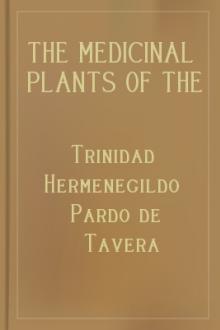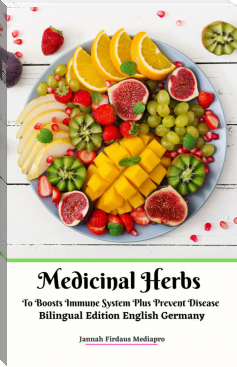The Medicinal Plants of the Philippines by Trinidad Hermenegildo Pardo de Tavera (best pdf ebook reader for android TXT) 📖

- Author: Trinidad Hermenegildo Pardo de Tavera
- Performer: -
Book online «The Medicinal Plants of the Philippines by Trinidad Hermenegildo Pardo de Tavera (best pdf ebook reader for android TXT) 📖». Author Trinidad Hermenegildo Pardo de Tavera
Thevetin and theveresin exercise a marked toxic effect on the heart. The former induces emetic and cathartic phenomena, trembling and progressive weakness. The latter does not cause vomiting or diarrhœa, but anæsthesia and rigidity of the limbs. Both poisons arrest the heart in systole. Injected hypodermically they are irritant, are eliminated by the liver, but are not found in the urine.
Botanical Description.—A shrub, about 10° high, with leaves nearly sessile, somewhat bunched at the ends of the branches and overlapping, lanceolate, entire, glabrous. Flowers about 2′ long. Calyx 5-toothed. Corolla straw-colored, cylindrical, very narrow below, but the limb very large, spreading into 5 lobes with greenish, superimposed borders. Stamens 5, inserted in the throat, anthers lanceolate. Ovaries 2, united at base, free above, unilocular. Style simple, enlarging at the base in a bilobed stigma. Fruit a fleshy drupe resembling somewhat a small apple, the pit very hard, semilunar, flattened, with 4 compartments and as many solitary seeds.
Habitat.—Common in all gardens and on the seashore.
Cerbera Odallam, Gaertn. (C. manghas, Bl. & Blanco.)
Nom. Vulg.—Toktok-kaló, Tag.
Uses.—The milky juice of the plant is emetic and purgative. The chemist De Vry has isolated from it a poisonous alkaloid analogous to “thevetin,” which has just been considered. The seeds are likewise emetic and toxic. The Javanese call the fruit “bimaro” and affirm that it possesses the same properties as “datura.” The bruised leaves are used locally for hepatic eruptions; the bark is used for the same purpose and is purgative.
The use of the plant is dangerous and is condemned by the Pharmacopœia of India.
Botanical Description.—A small shrub with forked branches. Leaves (overlapping) at ends of branches, lanceolate, entire, glabrous. Flowers in umbellate spikes. Calyx, 5 caducous lobules. Corolla white, twisted, cylindrical, with salver-shaped limb divided in 5 rhomboid lobes, throat stellate and woolly. Stamens 5. Filaments joined to the corolla, their ends thickened. Anthers arrow-shaped. Ovary, 2 uniovulate locules. Style, same length as stamens. Stigma thick, conical, lobulate. Two drupes joined at the base (one usually aborted), brown, large, oval, fleshy, with woody fibrous nut of a single flattened seed.
Habitat.—Luzon. Blooms in July.
Plumeria acutifolia, Poir. (P. alba, Blanco.)
Nom. Vulg.—Calachuche, Sp.-Fil.; Kalatsutsi, Kalasusi, Tag.
Uses.—This tree, beloved for its fragrant flowers, has a wide therapeutic use in India and the Philippines. The bark is a bitter hydragogue cathartic and is given in decoction (5–10 grams to 200 water) principally for dropsy; however the milky juice of the trunk is preferable for this purpose, given in emulsion in doses of 0.50–0.80 grams. The bark and the tips of the branches are given as an emmenagogue.
The bark of the root and of the trunk is an excellent remedy for blenorrhagia. The fresh bark is thoroughly comminuted and mixed with sweetened water in the proportion of 60 grams to 4 liters; this mixture is put in the sun for 4 days, and shaken from time to time. It is then strained and given in doses of 4–5 glassfuls a day, at the same time with refreshing and emollient drinks, and prolonged tepid baths. At first this preparation exerts a purgative action, but later acts upon the urinary organs, rapidly lessening the suppurative process in urethritis. The bark may also be associated with wine or beer, in the proportion of 30 grains to the liter, the dose being 2–4 small cupfuls a day and Dr. Grosourdy employs the extract of the bark in doses aggregating 0.20–0.25 gram a day, gradually increased till at the end of a week 6 grams are taken daily (Dr. J. Amadeo).
The bruised leaves are applied locally to contusions to reduce the swelling. The juice is used externally as a rubefacient in rheumatic affections of the joints. In Concan they use a decoction of the root for diarrhœa. The flower buds are chewed with buyo, for intermittent fever and the juice is applied locally for itch.
Peckolt and Geuther isolated from the bark the glucoside, agoniadin (C10H14O6), which crystallizes in silky crystals fusible at 155°, slightly soluble in water, alcohol, bisulphuret of carbon, ether and benzine; soluble in nitric or sulphuric acids. In solution it is a golden yellow soon changing to green. Boiled in a dilute acid it splits into glucose and an undetermined substance. Oudeman obtained plumieric acid (C10H10O5) from the milky juice deprived of its resin; the acid exists as microscopic, needle-like crystals, soluble in boiling water, alcohol and ether. It melts and decomposes at 130°.
Botanical Description.—A tree, 12–18° high, commonly cultivated for ornament, well known in the islands, almost constantly bearing fragrant flowers, but rarely bearing fruit. Branches forked and peculiarly stumpy at the ends. Leaves alternate, broad lanceolate, entire, glabrous, the apices curved downward. Petioles short. Flowers creamy white, light yellow in the throat. Calyx 5-toothed. Corolla twisted, funnel-form, 5-lobed. Stamens 5, hidden in depths of the tube. Anthers dart- or arrow-formed. Style very short, thickened above. Stigma 2-parted. Two horizontal, cylindrical and long follicles joined at their bases, with numerous seeds in hollow receptacles, each seed encircled by a wing.
Alstonia scholaris, Br. (Echites scholaris, L. and Blanco.)
Nom. Vulg.—Dita, Tag.; Dallopawen, Iloc.; Dita or Alstonia Tree, Eng.
Uses.—The trunk bark is a febrifuge of great importance; it is official in the Pharmacopœia of India and is widely used in the Philippines. Personally I have had occasion to use it in several cases of malarial fever in the town of San Mateo near Manila. It is astringent, anthelmintic and antiperiodic, highly useful in chronic diarrhœa and dysentery, not only for its astringent effects but for its tonic and restorative action. As a tonic it gives as good results as quinine. The dry powdered bark is given internally in wafers of 20–30 centigrams. The infusion is prepared from 15 grams of the dry comminuted bark to 300 of water. The dose is 30–60 grams 2 or 3 times a day.
Another convenient preparation is the tincture, 75 grams of the powdered bark macerated 7 days in 500 grams of alcohol, shaking from time to time. It is then filtered and enough alcohol added to make up the 500 cc. The dose is 4–8 grams a day.
I have often used the following wine as a tonic for convalescents and patients suffering from general debility: Finely powdered bark, 25 grams, muscatel or dry sherry one bottle; macerate a week, shaking every day, and filter; dose ½ wineglass with equal parts water a few minutes before each meal; children or very weak patients should take it after eating; it should always be diluted.
G. Grupe, a Manila pharmacist, treating the bark in 1883 by the same process as that used in the preparation of quinine, obtained a bitter substance which he named Ditaine. According to Grupe Dr. Pina used this substance with great success in the treatment of malarial fevers, but neither Grupe’s report nor Pina’s experiment are of any scientific value, inasmuch as they have neglected to mention the doses in which the so-called alkaloid was employed. Later analyses by Hesse and Jobst revealed several principles: two alkaloids ditamine (C16H19NO2), soluble in ether; Ditaine or Echitamine (C22H28NO4 + H2O) insoluble in ether, soluble in water; acetic acid and two amorphous substances dextrogyrous in ethereal solution, one of them a resin, Echicauchina (C25H40O2), the other neutral, Echiretin (C35H56O2); two crystallizable principles, dextrogyrous: Echicerin (C30H48O2), Echitein (C42H70O2) and Echitin (C32H52O2).
Ditaine is employed under the same circumstances and in the same dose as quinine. (The Hindoo writer, K. L. Dey, states that the plant yields an inferior quality of gutta-percha.)
Botanical Description.—A tree, 50 or more feet high, the trunk covered with small eminences resembling the scars of thorns. Branches radiating. Leaves radiating, 5, 6 or more, somewhat elliptical in form, pointed at the apex. Petioles very short, with a pointed glandule on the inner surface of the base. Flowers white, terminal, in umbellate racemes. Calyx very short, 5-toothed. Corolla twisted, tubular, the limb 5-lobuled; throat open, encircled with down. Stamens 5, hidden within the throat and inserted on the tube. Filaments almost wanting. Anthers arrow-shaped. Style as long as the stamens, somewhat flattened, a scarcely visible line throughout its length. Stigma bifid, placed above a cylindrical zone, two follicles, 1° long and 1″ thick, twisted like a string, containing the seeds in a row. Seeds cylindrical with a hairy awn at both ends.
Habitat.—In the forests of Luzon, especially in Batangas. Blooms in April.
Nerium odorum, Aiton. (N. oleander, L. and Blanco.)
Nom. Vulg.—Adelfa, Sp.; Baladri, Tag.; Sweet-scented Oleander, Eng.
Uses.—In the Philippines and in Spain this plant is well known to be poisonous. The bark and the leaves of both the red-flowered and white-flowered varieties are boiled in cocoanut oil and the product is used for inunction in itch and other skin diseases. The bruised root is a useful application for chancroids.
We have stated that the plant is poisonous, and indeed it is actively so in the tropics. It is now recognized as an energetic cardiac poison, comparable with strophanthus, destined to play an important part in therapeutics. Dr. Pouloux has made a study of the hydro-alcoholic extract of oleander and reports that it exerts a marked effect on the heart of frogs and rabbits, arresting them in systole. Where there is asystolia, such as we encounter in Bright’s disease, without compensation, it stimulates the heart and increases the urine in the same manner as digitalis. No contraindications to its use are as yet known. It occasions no disagreeable symptoms and may be used many days consecutively provided that the daily dose does not exceed 10–15 centigrams.
The poisonous properties of the plant reside in two alkaloids isolated by Lukowsky from the leaves: oleandrine, extremely toxic and pseudo-curarine, as its name indicates, resembling curare in its action. Oleandrin is yellow, semicrystalline, soluble in water, alcohol, ether, chloroform and olive oil; fusible at 70–75° and changing to a greenish oil. With HCl it forms a crystalline salt. It is a violent irritant of the mucous membranes and given internally it causes emesis, diarrhœa, tetanic convulsions and death. It arrests the cardiac movements in doses of 25 milligrams.
Loiseleur-Deslongchamps experimented with the drug on his own person, using a solution of 30 grams of the extract in 120 grams of wine. He began by taking three drops of this preparation four times a day, adding a drop to each dose every day, so that at the end of 12 days he was taking 48 drops between 6 a. m. and 9 p. m. He reached a maximum of 64 drops a day but was forced to abandon his experiment at that point on account of the unpleasant symptoms induced—loss of appetite, great weakness and muscular pains. His deduction was that the plant contained a “destructive and irritant principle.” The experiment is of interest as demonstrating the maximum dose of the drug.
The active principles of the plant reside principally in the leaves and bark, but that they are abundantly present in other parts is proved by the death of several soldiers in Corsica from having eaten meat roasted on a spit of oleander wood.
Botanical Description.—A small tree, about 6° high. Leaves coriaceous, lanceolate, entire, glabrous. Flowers in terminal cymes, rose-color or white, single or double. Calyx 5-parted. Corolla 15 petals, the inner ones larger, disposed in 3 groups of 5. Stamens 10, fixed on receptacle; filaments short. Style shorter than stamens. Two follicles, sharp-pointed, channeled, containing many imbricated seeds each with an awn.
Milkweed Family.
Calotrops gigantea, R. Br. (Asclepias gigantea, Willd. and Blanco.)
Nom. Vulg.—Kapal-kapal, Tag.; Swallow-Wort, Eng.; Mudar, Indo-Eng.





Comments (0)